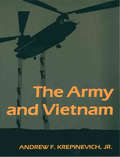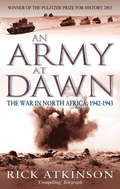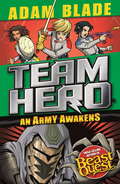- Table View
- List View
Army and State in Postcommunist Europe
by David Betz John LöwenhardtThis study explores the complex military issues that are raised by the transition to post-communist rule with particular reference to Russia, Ukraine, Bulgaria, and the new members of NATO. All faced similar problems yet their responses, it emerges, were surprisingly diverse.
The Army and the Indonesian Genocide: Mechanics of Mass Murder (Rethinking Southeast Asia)
by Jess MelvinFor the past half century, the Indonesian military has depicted the 1965-66 killings, which resulted in the murder of approximately one million unarmed civilians, as the outcome of a spontaneous uprising. This formulation not only denied military agency behind the killings, it also denied that the killings could ever be understood as a centralised, nation-wide campaign. Using documents from the former Indonesian Intelligence Agency’s archives in Banda Aceh this book shatters the Indonesian government’s official propaganda account of the mass killings and proves the military’s agency behind those events. This book tells the story of the 3,000 pages of top-secret documents that comprise the Indonesian genocide files. Drawing upon these orders and records, along with the previously unheard stories of 70 survivors, perpetrators, and other eyewitness of the genocide in Aceh province it reconstructs, for the first time, a detailed narrative of the killings using the military’s own accounts of these events. This book makes the case that the 1965-66 killings can be understood as a case of genocide, as defined by the 1948 Genocide Convention. The first book to reconstruct a detailed narrative of the genocide using the army’s own records of these events, it will be of interest to students and academics in the field of Southeast Asian Studies, History, Politics, the Cold War, Political Violence and Comparative Genocide.
The Army and the Indonesian Genocide: Mechanics of Mass Murder (Rethinking Southeast Asia)
by Jess MelvinFor the past half century, the Indonesian military has depicted the 1965-66 killings, which resulted in the murder of approximately one million unarmed civilians, as the outcome of a spontaneous uprising. This formulation not only denied military agency behind the killings, it also denied that the killings could ever be understood as a centralised, nation-wide campaign. Using documents from the former Indonesian Intelligence Agency’s archives in Banda Aceh this book shatters the Indonesian government’s official propaganda account of the mass killings and proves the military’s agency behind those events. This book tells the story of the 3,000 pages of top-secret documents that comprise the Indonesian genocide files. Drawing upon these orders and records, along with the previously unheard stories of 70 survivors, perpetrators, and other eyewitness of the genocide in Aceh province it reconstructs, for the first time, a detailed narrative of the killings using the military’s own accounts of these events. This book makes the case that the 1965-66 killings can be understood as a case of genocide, as defined by the 1948 Genocide Convention. The first book to reconstruct a detailed narrative of the genocide using the army’s own records of these events, it will be of interest to students and academics in the field of Southeast Asian Studies, History, Politics, the Cold War, Political Violence and Comparative Genocide.
The Army and the Radical Left in Turkey: Military Coups, Socialist Revolution and Kemalism
by Özgür Mutlu UlusIn 1960s Turkey, the armed forces and the radical leftist movement provided two very dynamic, but very different, political forces. However, somewhat surprisingly, the majority of radical leftists believed in the revolutionary potential of the armed forces in overthrowing the current regime and replacing it with a quasi-socialist one. This book considers the changing perspectives of the radical leftist movement towards the political role of the military in Turkey. Using a textual analysis of different leftist groups, including the Communist Party of Turkey, Ozgur Mutlu Ulus describes the development of the leftist movement in Turkey after the 1960 coup and explains why most leftists chose to encourage a military revolution, which they hoped would bring about the triumph of socialism in Turkey.
The Army and the Radical Left in Turkey: Military Coups, Socialist Revolution and Kemalism (Library Of Modern Middle East Studies)
by Özgür Mutlu UlusIn 1960s Turkey, the armed forces and the radical leftist movement provided two very dynamic, but very different, political forces. Yet, somewhat surprisingly, the majority of radical leftists in this period believed in the revolutionary potential of the armed forces in overthrowing the existing regime and replacing it with a quasi-socialist one. Covering the time between the two successful military interventions of 1960 and 1971, The Army and the Radical Left in Turkey considers the changing perspectives of the radical leftist movement towards the political role of the military in Turkey in this period.The democratic reforms which followed the 1960 coup allowed leftist groups to operate legally for the first time, and as a result, Marxist or quasi-Marxist groups expanded and diversified enormously in the years that followed. But one of the significant problems faced by the leftist movement in the 1960s was factionalisation and the issue of why the left could not maintain unity in Turkey during this period. Ulus argues here that differing and opposing attitudes towards the armed forces within the leftist movement was one of the key causes of factionalisation – and that these differences became even more noticeable towards the end of the 1960s. Examining the development of the leftist movement, its understanding of Kemalism, as well as the discourses and actions of the different leftist groups, including the Communist Party of Turkey and the Workers' Party of Turkey, Ulus analyses the political thought and organisational structures of these groups. She thereby shows why some leftists chose to encourage a military revolution, which they hoped would bring about the triumph of socialism in Turkey, but instead led to their downfall. As the 1960s ended with the radical left in disarray, this book will be invaluable for researches of the parties of the left across the Middle East, as well as scholars of modern Turkish history and politics.
The Army and Vietnam
by Andrew F. Krepinevich Jr.Many senior army officials still claim that if they had been given enough soldiers and weapons, the United States could have won the war in Vietnam. In this probing analysis of U.S. military policy in Vietnam, career army officer and strategist Andrew F. Krepinevich, Jr., argues that precisely because of this mindset the war was lost before it was fought.The army assumed that it could transplant to Indochina the operational methods that had been successful in the European battle theaters of World War II, an approach that proved ill-suited to the way the Vietnamese Communist forces fought. Theirs was a war of insurgency, and counterinsurgency, Krepinevich contends, requires light infantry formations, firepower restraint, and the resolution of political and social problems within the nation. To the very end, top military commanders refused to recognize this.Krepinevich documents the deep division not only between the American military and civilian leaders over the very nature of the war, but also within the U.S. Army itself. Through extensive research in declassified material and interviews with officers and men with battlefield experience, he shows that those engaged in the combat understood early on that they were involved in a different kind of conflict. Their reports and urgings were discounted by the generals, who pressed on with a conventional war that brought devastation but little success.A thorough analysis of the U.S. Army's role in the Vietnam War, The Army and Vietnam demonstrates with chilling persuasiveness the ways in which the army was unprepared to fight—lessons applicable to today's wars in Afghanistan and Iraq.
Army Ants: Nature's Ultimate Social Hunters
by Daniel J. KronauerA richly illustrated, captivating study of army ants, nature’s preeminent social hunters.A swarm raid is one of nature’s great spectacles. In tropical rainforests around the world, army ants march in groups by the thousands to overwhelm large solitary invertebrates, along with nests of termites, wasps, and other ants. They kill and dismember their prey and carry it back to their nest, where their hungry brood devours it. They are the ultimate social hunters, demonstrating the most fascinating collective behavior.In Army Ants we see how these insects play a crucial role in promoting and sustaining the biodiversity of tropical ecosystems. The ants help keep prey communities in check while also providing nutrition for other animals. Many species depend on army ants for survival, including a multitude of social parasites, swarm-following birds, and flies. And while their hunting behavior, and the rules that govern it, are clearly impressive, army ants display collective behavior in other ways that are no less dazzling. They build living nests, called bivouacs, using their bodies to protect the queen and larvae. The ants can even construct bridges over open space or obstacles by linking to one another using their feet. These incredible feats happen without central coordination. They are the result of local interactions—self-organization that benefits the society at large.Through observations, stories, and stunning images, Daniel Kronauer brings these fascinating creatures to life. Army ants may be small, but their collective intelligence and impact on their environment are anything but.
An Army At Dawn: The War in North Africa, 1942-1943 (Liberation Trilogy #Vol. 1)
by Rick AtkinsonThe liberation of Europe and the destruction of the Third Reich is a story of courage and enduring triumph, of calamity and miscalculation. In this first volume of the Liberation Trilogy, Rick Atkinson shows why no modern reader can understand the ultimate victory of the Allied powers without a grasp of the great drama that unfolded in North Africa in 1942 and 1943.Beginning with the daring amphibious invasion in November 1942, An Army at Dawn follows the British and American armies as they fight the French in Morocco and Algeria, and then take on the Germans and Italians in Tunisia. Battle by battle, an inexperienced and sometimes poorly led army gradually becomes a superb fighting force. Central to the tale are the extraordinary but fallible commanders who come to dominate the battlefield: Eisenhower, Patton, Bradley, Montgomery and Rommel.
An Army Awakens: Series 4 Book 4 (Team Hero #3)
by Adam BladeX-Men meets Beast Quest at the school for superheroes! An epic new adventure series from bestselling author Adam Blade - with amazing comic-book style illustrations. TEAM HERO VS THE AGENT! IT IS TIME FOR JACK, RUBY AND DANNY TO FACE THE DREADED AGENT. CAN THEY RESTORE THE SHARDS OF ETHER BEFORE THEY ARE USED FOR UNSPEAKABLE EVIL?There are FOUR thrilling adventures to collect in this series - don't miss out! Book 1: The Secret Jungle, Book 2: Ninja Strike, Book 3: The Night Thief, Book 4: An Army AwakensAnd don't forget Adam Blade's other series: Beast Quest and Sea Quest
Army Childhood: British Army Children’s Lives and Times (Shire Library)
by Clare GibsonAn army childhood is a peripatetic childhood. Beginning with the establishment of Britain's standing army, Clare Gibson sheds light on such crucial aspects of the army-child experience as the places that they have called home and how they have been transported, housed, educated and entertained while in the army's care. This informative and evocatively illustrated book will appeal to those interested in British military history's social side, and to those seeking to understand what life was like for an erstwhile army-child ancestor. It is also essential reading for those who were once themselves 'barrack rats', 'pads brats' or 'army brats', for whom it is sure to arouse nostalgic memories.
Army Childhood: British Army Children’s Lives and Times (Shire Library #671)
by Clare GibsonAn army childhood is a peripatetic childhood. Beginning with the establishment of Britain's standing army, Clare Gibson sheds light on such crucial aspects of the army-child experience as the places that they have called home and how they have been transported, housed, educated and entertained while in the army's care. This informative and evocatively illustrated book will appeal to those interested in British military history's social side, and to those seeking to understand what life was like for an erstwhile army-child ancestor. It is also essential reading for those who were once themselves 'barrack rats', 'pads brats' or 'army brats', for whom it is sure to arouse nostalgic memories.
The Army Doc's Baby Bombshell: Playboy On Her Christmas List / The Army Doc's Baby Bombshell (Mills And Boon Medical Ser.)
by Sue MacKayFrom one night…to baby surprise!
The Army Doc's Baby Secret (Mills And Boon Medical Ser.)
by Charlotte HawkesHis wife is back… …with his secret son!
The Army Doc's Christmas Angel (Hope Children's Hospital #3)
by Annie O'NeilLetting go of his past… …to embrace their future!
The Army Doc's Secret Princess (Mills And Boon Medical Ser.)
by Emily ForbesCould her royal fling… …last a lifetime?
The Army Doc's Secret Princess / Reunited With Her Hot-Shot Surgeon: The Army Doc's Secret Princess / Reunited With Her Hot-shot Surgeon (Mills And Boon Medical Ser.)
by Emily Forbes Amy RuttanOne final royal fling? Princess Viktoria wants one last adventure before marrying for duty. So she welcomes the freedom that working incognito at the Legion’s Games gives her. There’s only one tall, dark and brooding problem – her attraction to surgeon Campbell Hamilton.
The Army Doc's Secret Wife: The Prince And The Midwife / His Pregnant Sleeping Beauty / One Night, Twin Consequences / Twin Surprise For The Single Doc / The Doctor's Forbidden Fling / The Army Doc's Secret Wife (Mills And Boon Medical Ser. #6)
by Charlotte HawkesFalling for her husband? Theirs was a marriage of convenience borne out of desperate circumstances, but Thea can’t forget the wedding night she spent in Ben Abrams’ arms! Only by dawn it was all over, and her army doctor husband had shipped out—of the country and her life!
Army, Empire and Politics in Meiji Japan: The Three Careers of General Katsura Tar?
by S. LoneDramatic innovations in modern Japan include a mass army, overseas empire, and constitutional polity. This is the first book to link these changes in the Meiji era (1868-1912). It focuses on the life of General Katsura Taro, one of the architects of the modern military, a leading figure in Japanese colonialism, and prime minister through the 1900s. Challenging the received wisdom about Japanese militarism and imperialism, it exposes the army's ambivalence about empire but also its positive role in political change.
Army Girls: The secrets and stories of military service from the final few women who fought in World War II
by Tessa DunlopArmy Girls is the intimate story of the final few women who served in World War II and are still alive to tell their tale. They were female soldiers in a war Britain wanted to fight without conscripting women. It was a vain hope, by December 1941 for the first time in British history women were called up and a generation of girls came of age in khaki, serving king and country. Barbara trained to drive army-style in giant trucks and Grace swapped her servant's pinafore for battledress and a steel hat, Martha turned down officer status for action on a gun-site and Olivia won the Croix de Guerre in France.Commemorating the 80th anniversary of conscription for women, Army Girls captures remarkable stories from the last surviving veterans who served in Britain's female army and brings to life a pivotal moment in British history. Precious memories and letters are entwined in a rich narrative that travels back in time and sheds new light on being young, female and at war.Uniquely this moving Second World War memoir is embedded in the present day. Written in the midst of a global pandemic, the parallels and paradoxes between two very different national crises are explored in a book that honours the women who fought on in extreme youth and now once more in great old age.
The Army in British India: From Colonial Warfare to Total War 1857 - 1947 (Bloomsbury Studies in Military History)
by Kaushik RoyThe army in India was the principal pillar of British power in South Asia from the mid-nineteenth century until Indian independence. This volume aims to evaluate the combat effectiveness of the army in British India from the mutiny of 1857 until the British departed India in 1947. It examines how the army in India developed from a colonial police force into one of the world's largest volunteer armies which saw service around the globe. The author presents new primary material from international archival sources and develops original interpretations of the political and military role of the army in colonial India. These new arguments include: the army's conduct of 'small wars' on the North-West frontier aided it in conducting tactical warfare in Burma during World War II; small unit raids developed in India were put to good effect beyond India's borders; the army's practical experience of counter-insurgency was used in Greece and Indonesia after 1945; and, contrary to existing scholarship, the British did not follow a deliberate policy of 'Indianization' of the officer corps .
The Army in British India: From Colonial Warfare to Total War 1857 - 1947 (Bloomsbury Studies in Military History)
by Kaushik RoyThe army in India was the principal pillar of British power in South Asia from the mid-nineteenth century until Indian independence. This volume aims to evaluate the combat effectiveness of the army in British India from the mutiny of 1857 until the British departed India in 1947. It examines how the army in India developed from a colonial police force into one of the world's largest volunteer armies which saw service around the globe. The author presents new primary material from international archival sources and develops original interpretations of the political and military role of the army in colonial India. These new arguments include: the army's conduct of 'small wars' on the North-West frontier aided it in conducting tactical warfare in Burma during World War II; small unit raids developed in India were put to good effect beyond India's borders; the army's practical experience of counter-insurgency was used in Greece and Indonesia after 1945; and, contrary to existing scholarship, the British did not follow a deliberate policy of 'Indianization' of the officer corps .
The Army in India and the Development of Frontier Warfare, 1849-1947 (Studies in Military and Strategic History)
by T. MoremanThis comprehensive study is the first scholarly account explaining how the British and Indian armies adapted to the peculiar demands of fighting an irregular tribal opponent in the mountainous no-man's-land between India and Afghanistan. It does so by discussing how a tactical doctrine of frontier fighting was developed and 'passed on' to succeeding generations of soldiers. As this book conclusively demonstrates this form of colonial warfare always exerted a powerful influence on the organisation, equipment, training and ethos of the Army in India.
The Army in the Roman Revolution
by Arthur KeaveneyThe Roman Revolution is one of the most momentous periods of change in history, in which an imperial but quasidemocratic power changed into an autocracy. This book studies the way the Roman army changed in the last eighty years of the Republic, so that an army of imperial conquest became transformed into a set of rival personal armies under the control of the triumvirs. It emphasizes the development of what has often been regarded as a static monolithic institution, and its centrality to political change.
The Army in the Roman Revolution
by Arthur KeaveneyThe Roman Revolution is one of the most momentous periods of change in history, in which an imperial but quasidemocratic power changed into an autocracy. This book studies the way the Roman army changed in the last eighty years of the Republic, so that an army of imperial conquest became transformed into a set of rival personal armies under the control of the triumvirs. It emphasizes the development of what has often been regarded as a static monolithic institution, and its centrality to political change.
Army, Industry and Labour in Germany, 1914-1918
by Gerald FeldmanThis innovative study by one of the leading specialists in the field examines the social and economic role of the German army in the nation's internal affairs during the First World War. This was the area in which the influence of the army was most direct and profound. Germany's wartime economic mobilisation was both planned and directed by the army, and as a consequence of this largely unanticipated responsibility, the army was compelled to cope with the great social conflicts of Imperial Germany. In the process of confronting the groups representing army and labour, the army paved the way for the establishment of collective bargaining in Germany and also created the foundations for the postwar inflation.




















